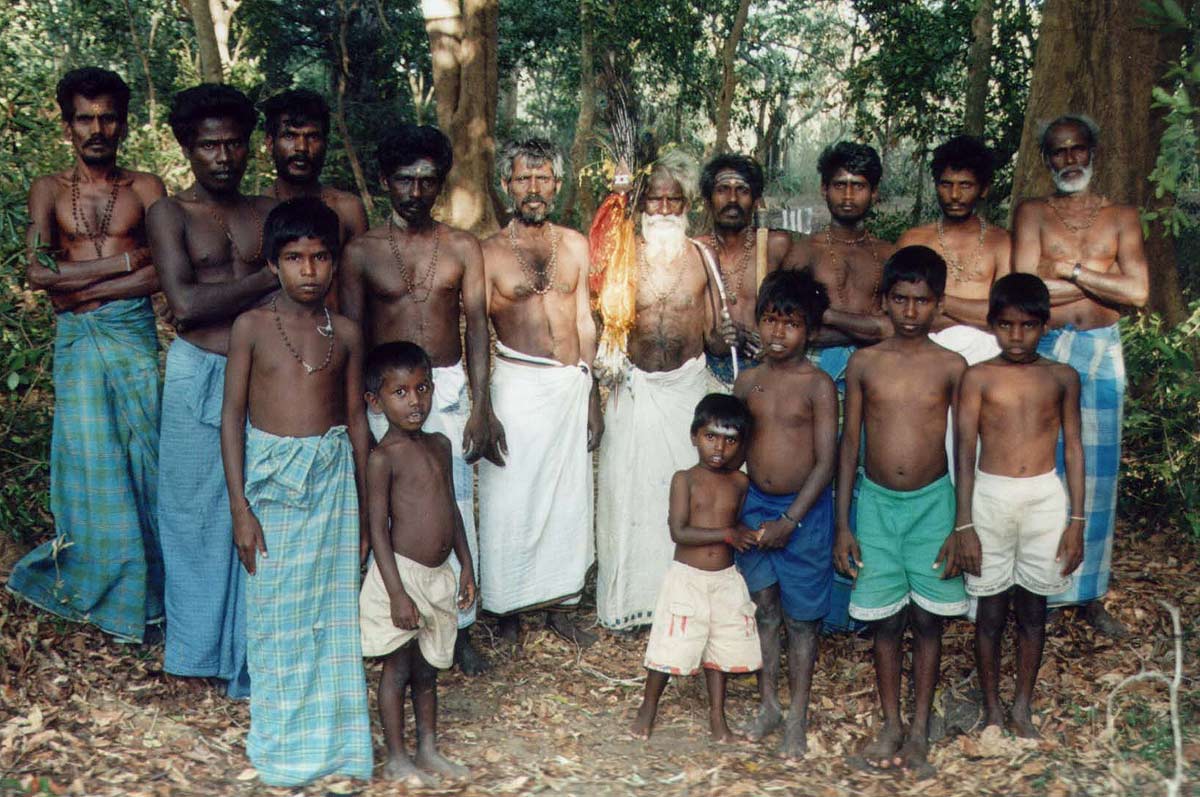From The Veddas by C.G. and Brenda Z. Seligmann (1911), pp. 331-335
THE Coast Veddas or Vedars occupy a number of settlements in the Tamil zone on the east coast. They exceed in number both the Village Veddas of Bintenne and their wilder neighbours of the borders of Uva and the Eastern Province; this is no doubt due to the fact that in the majority of Coast Veddas there is a large admixture of Tamil blood, and the comparatively thriving condition of their settlements must be attributed to the same cause. The date of their first arrival on the coast and of their subsequent intermarriage with the Tamils is quite uncertain; the latter state that there have always been Veddas in the neighbourhood of the sites they now occupy, but the Veddas themselves have a tradition that they come from inland. Knox does not mention them, but Nevill considers that they come from Sabaragamuwa (Sufferagam), being driven thence in the 17th century.
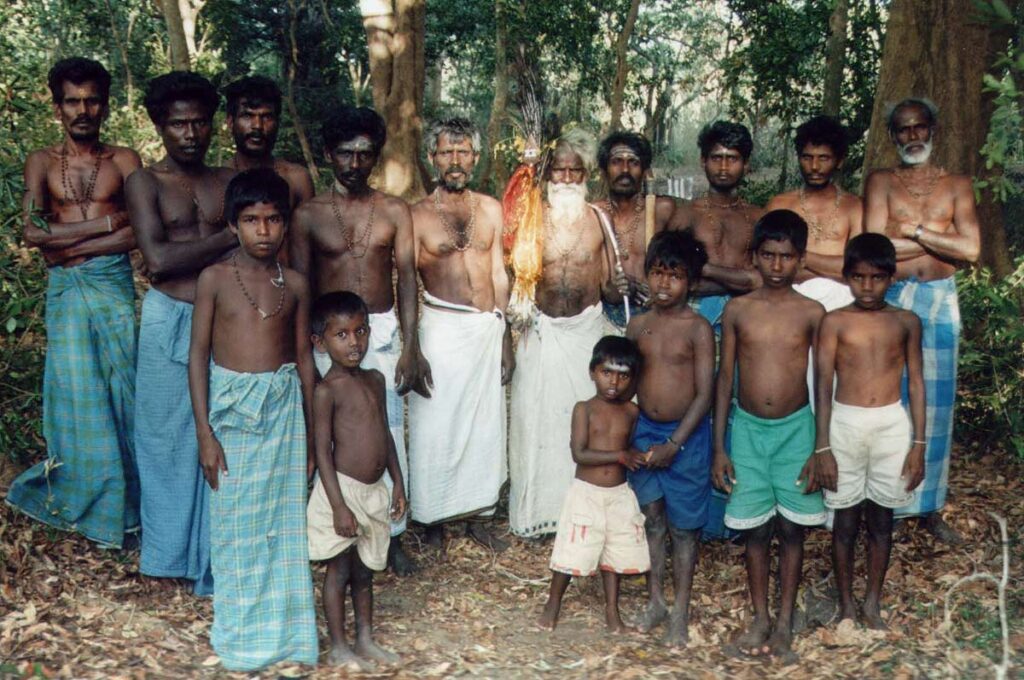
“The Vaeddas say that they never were related to these Coast Vaeddas, and do not know when they came to the Coast, or where they came from, nor did they ever hear that they belonged to any waruge of the race.
“The Coast Vaeddas do not know when they came or how they came, but they say that long ago their ancestors came from the Gala, far beyond the hills to the west. They also sometimes say they came from Kukulu-gammaeda and spread out along the Coast. Some say this is Kukulugam near the Verukal; others suppose it to be somewhere far away[1].”
We found that the Coast Veddas spoke of themselves as Vedars and said that long ago their fathers came from inland. They all speak Tamil, but some assert that they still know, and at times use among themselves, their old Vedda language, but when we asked the men who made this statement to speak in their ancestral dialect they spoke Sinhalese[2]. Besides this a few of the older men know the names of some of the Vedda waruge, while others are able to trace their descent to them.
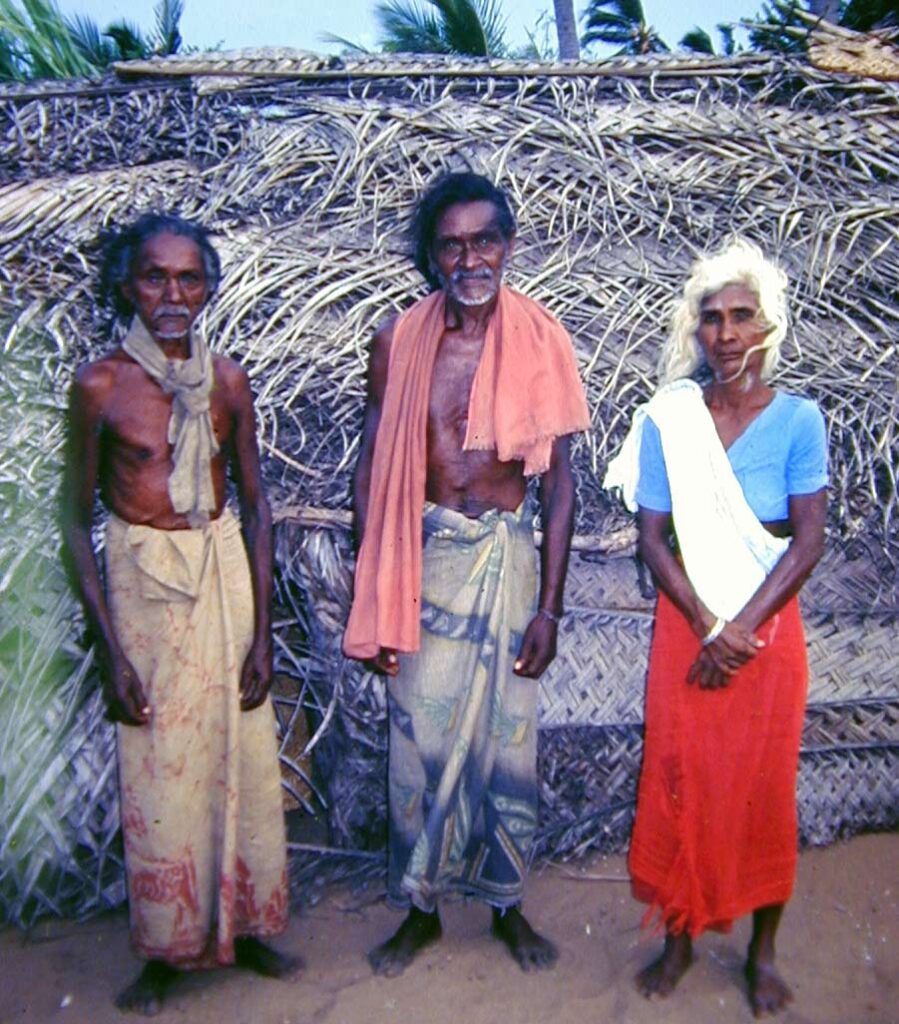
The Coast Vedda is darker, taller and more stoutly built than the true Veddas. In fact they generally resemble low caste Tamils, yet in almost every settlement there are one or two men shorter than their comrades and presenting an almost typical Vedda caste of countenance. The women are all much bigger than true Vedda women and would pass for Tamils, after whose fashion they dress.
Plate LXVIII, figs. 1 and 2, represent Vedars from settlements to the north of Kalkudah.
Plate LXVIII
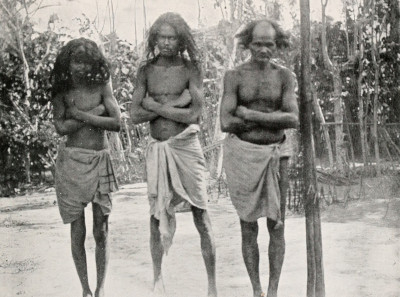
Fig. 1. Coast Veddas
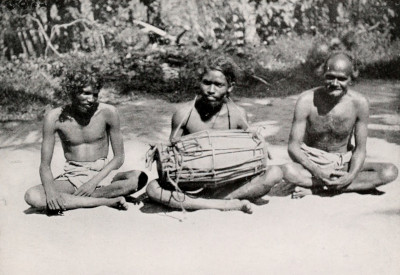
Fig. 2. Coast Veddas of Vakarai, early 20th century
The Vedars build comfortable huts in small clearings, usually within a mile of the sea; they cultivate maize and pumpkins and other easily grown crops round their houses and in patches of clearing in the surrounding jungle.
They have plenty of pots and baskets and also possess drums and fishing gear, so that their mode of life differs but little from that of the poor and low caste Tamils who are their neighbours. One, two, or more rarely, three houses stand in each clearing, and it seems that the people living in each clearing are closely related by blood or connected by marriage.
The chief Vedar settlements north of Batticaloa are Pellanchenai near Kalkudah 20 miles from Batticaloa and at Varkanari some 10 miles north of Kalkudah on the far side of the river which is crossed by a ferry at Valaichchenai. At Panichchenkeni some 14 miles further north is another ferry, where the local Vedars act as ferrymen, while there are two other Vedar settlements some three miles beyond the ferry at sites called Vellaiade and Kandaladi respectively.
Plate LXIX
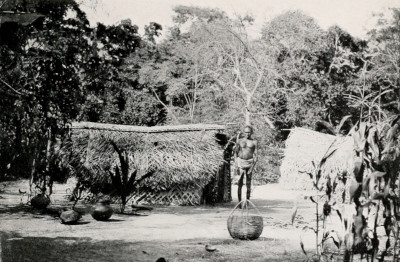
Fig. 1. Settlement of Coast Veddas
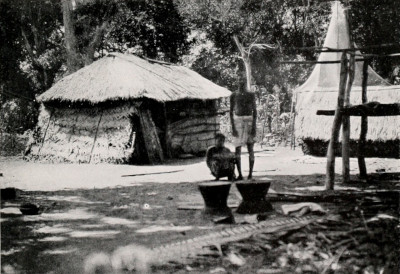
Fig. 2. Settlement of Coast Veddas
There are a few Vedars at Panichchenkeni, while near Vakarai still further to the north there is a Vedar settlement of considerable size. Some eight miles beyond this are two Vedar settlements Parchenai and Nargantonai situated close together. We heard of other smaller settlements of Coast Veddas in the neighbourhood of Batticaloa, but these were not visited as time was short and it appeared that those Vedars we did not see differed in no respect from those we met. We were told that formerly there were Coast Veddas south of Batticaloa and we later discovered that there were, and still are, certain shrines or temples within a few miles of the coast (e.g. at Mandur), which were generally recognised as Vedda shrines at which Veddas especially worshipped. This matter has been alluded to in Chapter VIII, and here it is only necessary to point out that the religion of the Coast Veddas is strongly tinged with Tamil customs and beliefs; indeed, many Vedars had Hindu sect marks upon their foreheads.
Some, but not all, of the Coast Veddas know the names of the waruge to which they belong, and a few also know the names of some of the more important waruge of the Veddas inland. Uru waruge appears to be the waruge to which most of the Coast Veddas who remembered their ancestral waruge belonged, but a few men stated that they belonged to Ogatam, Kavatam, Umata or Umatam, Aembalaneduwe and Aembale waruge; the last named and the one before it probably being the same as the Aembela waruge found inland. Some of the Coast Veddas whom we questioned said they had heard of, and still knew of certain of the old Vedda waruge, and such men were generally able to mention Morane waruge while fewer also knew of Unapane waruge.

The Coast Veddas have become expert fishermen and make and use various forms of nets including a cast net. They also spear and shoot fish, using a bifid iron spearhead which they have adopted from the Tamils. For shooting fish they use the usual Vedda bow, but the arrow has become a harpoon with a shaft as long as the bow into which the iron with its running line fits loosely. One of the nets used by the Coast Veddas is seen drying behind the house in the background of Plate LXIX, fig. 2, while Mr Storey’s book contains an excellent photograph of these people spearing fish[3].
The length of the Vedar bow and harpoon shaft shown in fig. 13 are 208 cm. and 220 cm. respectively. The bow is an extremely powerful weapon, its diameter at its thickest part being about 3.3 cm.
In spite of the perfectly obvious fact that the majority of the Vedars are more Tamil than Vedda the old Vedda pride of blood survives and some of the older Vedars denied that they intermarried with Tamils.
Children of marriages in which the waruge of the contracting parties were known took their father’s waruge but it seemed to be a matter of no account whether or no individuals of the same waruge intermarried.
Everyone avoids eating fowl and all our informants both male and female denied that they ever ate it, though often suggesting that others might do so. On the other hand, one informant who bred fowls for sale summed the matter up with an emphatic “Veddas don’t eat fowls.” No reason was given for this abstinence but all agreed that their ancestors had not eaten fowl, though the majority of our informants admitted that they would breed fowls for sale and kill and prepare fowls for others to eat. Beef was said to be generally avoided though it was not clear what opportunities existed for obtaining it. Deer and pig would be killed and eaten, and snakes were said to be killed without a scruple though one informant denied that he would kill a cobra.
Time did not allow of any systematic study of the religion of the Vedars, but it was clear that this had been much affected by Tamil influence while yet retaining some of the more obvious outward features of the Vedda cult of the dead. Unfortunately we had no opportunity of ascertaining definitely whether the Vedars have also retained the essence of the Vedda cult, i.e. the belief in the loving-kindness and the guiding influence of the spirits of their dead, though since the leader of the dance seen at Vakarai showed the classical signs of “possession,” there seems to be every reason to hold this belief at least provisionally. The dance we saw rehearsed at Vakarai was said to be performed for sickness and in thanksgiving when a good harvest had been gathered. The dance took place at night, the men dancing in relays till daylight, the women squatting on the ground, but taking no part. No food is taken during the dance, but some is placed upon the “altar” kudaram (lit. cage or small shed, T) which is eaten by all in the morning.
The temple seen at Pellanchenai, of which a rough plan is given in fig. 14, was a building some 12 feet long by about 10 broad; it faced east and the roof was carried forward for a few feet beyond the front wall in which was a door. A stout pole (marked P), thought to be some 30 feet long and consisting of a young tree with the bark removed, stood in front of the temple about 30 feet from the entrance. To the north of the pole and about 8 feet from it was a hole in the ground F, really a small well containing water, while to the south of the pole and at a distance of about 12 feet from it there was a young tree before which a small platform T (kudaram) was built, on which a rough stone rested. Some distance beyond the pole and somewhat to the south of it stood a tree H, apparently quite dead, with a fringe of dried leaves and small twigs round its trunk, before which were the remains of a kudaram; to the south-west of the pole and roughly in the position of Y in the plan, a limb of a tree was planted in the soil. The branches springing from the upper end of this limb had been removed with the exception of three which were left to support between them a rough earthenware pot. The remains of a kudaram also existed somewhat to the south-east of the doorway about the spot marked X on the plan. The post supporting the weight of that portion of the roof extending beyond the door had tied round it a fringe of dried shredded coconut leaves. Within the temple stood a kudaram (marked K) behind which in one corner of the temple was a model of a sailing boat about two feet long partly square-rigged and clearly meant to imitate a European ship. The temple was for the worship of Kapalpei, Ammal and Komara Devam. The name Kapalpei means ship-demon. We could only discover that he is regarded as the most powerful of the beings worshipped and that he is a foreigner who reached the country in a ship. Ammal is a Tamil Goddess who sends smallpox and skin disease[4].
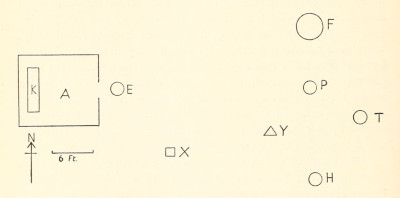
Fig. 14. Plan of Vedar temple and its surroundings.
We could at the time discover nothing concerning Komara Devam, though doubtless he is the same as Kumara Deva, an immigrant deity, whose characteristic weapon is a silver sword, who was one of the chief spirits invoked to remove sickness by the inhabitants of Gongolla a primitive jungle village some 20 miles from the coast in the Eastern Province[5].
When the dance, of which we saw a partial rehearsal, is about to take place the inside of the temple is decorated with cloths and the green branches of trees including coconut leaves, and the model of the boat which commemorates the arrival of Kapalpei is hoisted to the top of the tall pole standing outside the temple. If the dance is undertaken in order to cure a sick man, milk is placed in the pot which is supported on the rough stand (fig. Y) mentioned above. The sick individual, and probably the dancers, are fed from this and at the end of the night’s dance the last portion is thrown out into the jungle for Kapalpe.
The dancers should wear a petticoat made of strips of coconut leaves and green leafy twigs of other trees, and it was stated that the ministrant wore these just as did the other dancers. After the dance a number of these ceremonial garments are preserved in the temple where they are allowed to dry. Rice, plantain and chewing material are piled on the kudaram during the ceremony and camphor is burnt. Kapalpe sees the food provided and the honour done him and is propitiated.
The stone pilliyar has been frankly adopted from the Tamils though Mr Kumarakulasinghe pointed out that no sacred Tamil stone was so rough[6]; further, according to the same informant Tamils do not dance round either pilliyar or kudaram.
At Kalkudah it was said that there was a special “priest” or ministrant whom we did not see. We gathered that in some way he officiated in connection with the land cultivated by the community and he perhaps corresponded to the Sinhalese gamarale.
Some idea of the actual character of the ceremony and of the nature of the kudaram and pole can be derived from the dance rehearsed for our benefit at Vakarai. Plate LXX, fig. 1 shows the site selected for the dance and the arrangements made. The dancing ground consisted of one of those sandy spaces surrounded by a growth of scrub and low trees which are so common on the east coast. A kudaram, the upper part of which was covered with leaves, had been prepared, the top of this was depressed so as to present a sort of tray upon which a white cloth was laid; within the tray were laid flowers, which in this case did duty for the food offered in the ceremony. No model of a ship was hoisted to the top of the pole, which was encircled by wreaths of small leafy bunches at heights of about 6 to 12 feet from the ground.
There were five dancers, each of whom held a bunch of leafy twigs in each hand, which when the dance began were held against the body just below the umbilicus.
The leader of the dance was an old man who held a piece of cloth instead of a bunch of leaves. Behind each dancer stood a man who supported him by clapping his hands round the dancer’s body below the latter’s hands, i.e. over the hypogastric and epipubic region. At first the dancers faced the kudaram, their hands being held low against their thighs, but soon they began to move round the altar in single file (Plate LXX, fig. 2). As they danced they began to quiver, the rippling motion of their muscles from the knees upwards becoming progressively more violent, until as the dancers moved round the altar the majority of their superficial muscles all over the body were twitching irregularly. As the dance became quicker the dancers feigned exhaustion, leaning or falling back into the arms of their supporters, but this did not last long and dancing was not interrupted; soon the men left the altar and danced round the pole, the irregular quivering of their muscles being very striking. At times they shouted and raised the bunches of leaves which they held in their hands above their heads. They continued to dance round the altar and round the pole alternately; as they danced round the pole their movements became more violent, the men supporting the dancers let go and the latter now danced and leapt round the pole and beat the leaves tied to it with the leaves they held in their hands. As the vigour of their movements lessened, their supporters, who had been following their motions, once more put their arms round them, soon after which the dancers fell limply into their arms. The leader of the dance seemed especially excited at this stage and, trembling and quivering all over, stood back to the pole and wildly waved his scarf in the air. Soon his movements became less vigorous, his head nodded on his shoulders and hung down on his chest as he addressed the other dancers in a harsh and broken voice (Plate LXXI). In view of the Vedda ceremonies which we subsequently saw we have no doubt that he prophesied good fortune. It appeared to us that this old man really presented the ordinary characteristics of Vedda “possession,” i.e. the dance, though only a rehearsal, had produced the customary effects associated with it, and certainly this old man’s muscles continued to quiver irregularly for some time after the dance was over. As for the remaining dancers we have no doubt that the dance remained for them as it had begun, simply a rehearsal and an amusing piece of acting.
Plate LXX
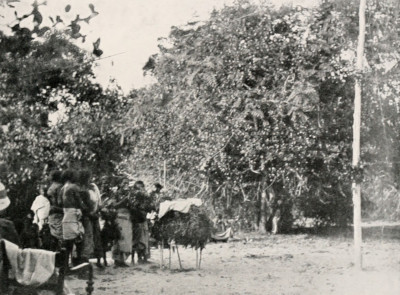
Fig. 1. Site of dance at Vakarai, showing kudaram and pole
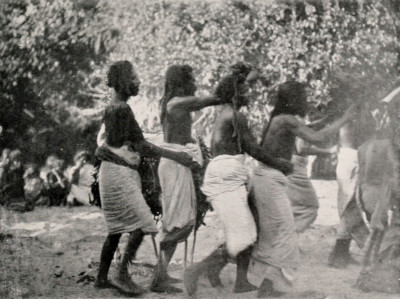
Fig. 2. Dancing around the kudaram
Plate LXXI
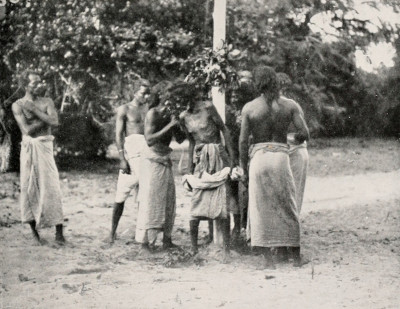
Fig. 1. The end of the dance at Vakarai
Such dances are held only to cure sickness or in return for good crops, and it was emphatically denied that anything similar took place after childbirth or death.
Very little was elicited concerning death and mourning ceremonies. The corpse is washed, and it seemed that although this is usually done by a barber or dhobie (professional washerman) it might be done by one or more of the relatives of the dead man. The grave must be at some distance from the habitations of the living and also from their cultivation patches. No fire is lit on the grave. A feast is held a few days after burial, which appears to be called bati bane, and the food for this, especially rice, is provided by the near relatives of the dead man and distributed. A kudaram is built upon which the food is placed for “a short time” as an offering to Kapalpei, after which it is eaten by the assembled people.
This account agrees with that given by the Sarasins, who record that a coast Vedda, Pereman, when asked about his religion “laughed and said they had that of the Tamils, they honoured their dead by cooking rice in front of their house, folding their hands, saying a few words and then eating the rice. As they did this they spoke the name of the deceased and said: ‘ Help us in danger, sickness etc.’ When we enquired whether their dead lived on as spirits he replied, they did not consider whether the departed were living or dead, they were just spirits, in Tamil sami or dewi, in Sinhalese yako; all spirits were alike, neither good nor bad. Another coast Vedda named Patiniya told us that their religion was that of the Tamils. In memory of their dead, whom they called yako, they cooked rice and ate it; they invoked the yaka in sickness, etc.[7]“
Just as Kapalpei sent sickness, so death was also attributed to him, but perhaps not epidemics, for it appeared to be generally considered that a single death would satisfy him for the time, so that it would be days or weeks before he would be expected to send sickness or death again.
